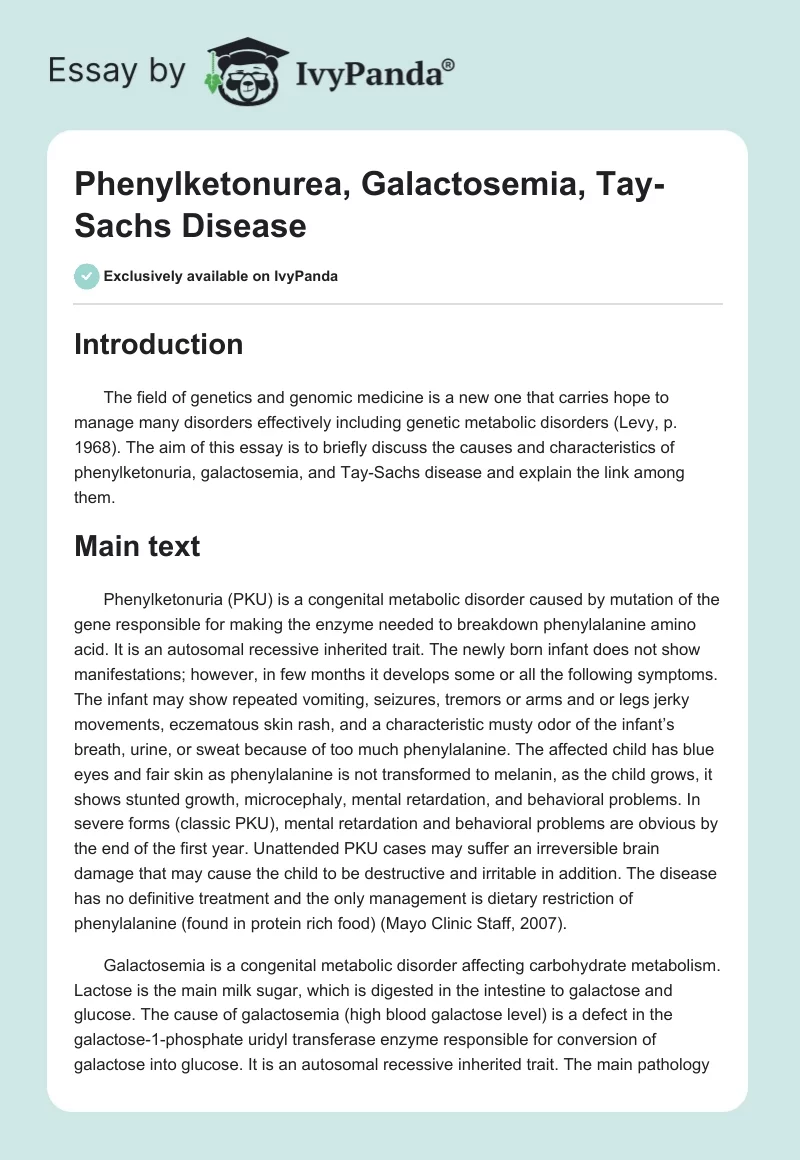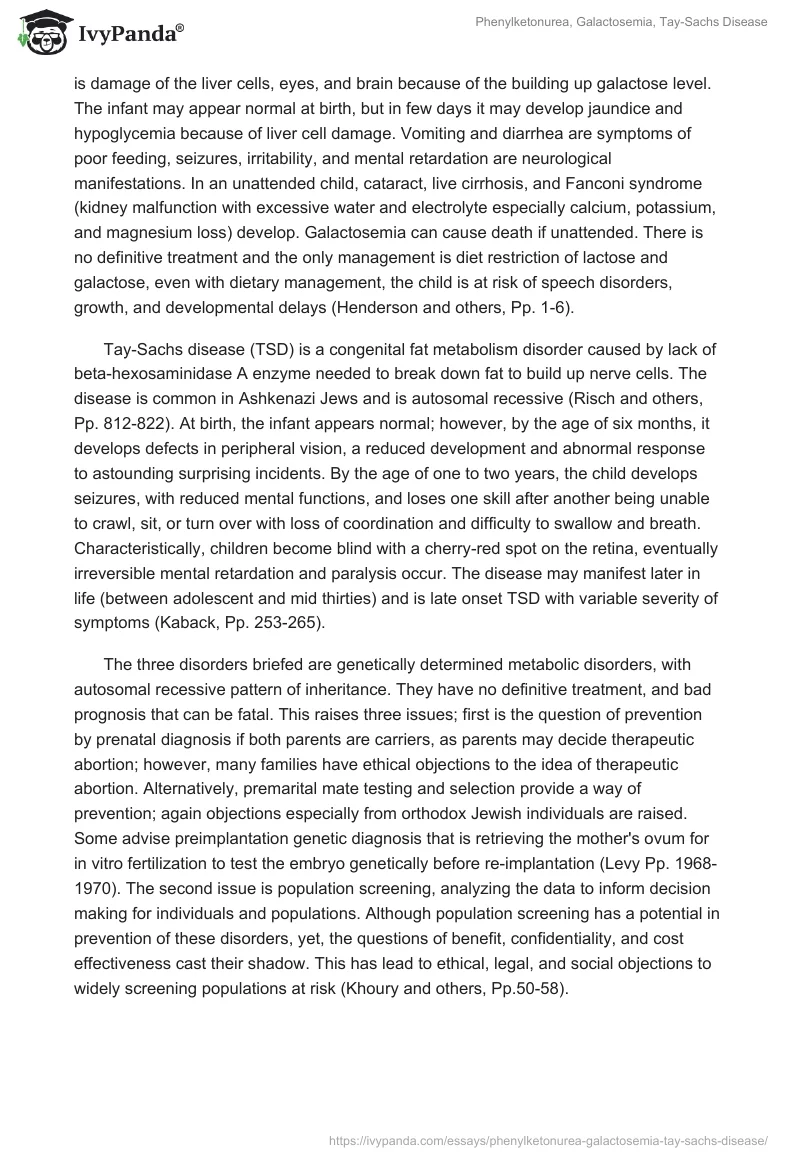Introduction
The field of genetics and genomic medicine is a new one that carries hope to manage many disorders effectively including genetic metabolic disorders (Levy, p. 1968). The aim of this essay is to briefly discuss the causes and characteristics of phenylketonuria, galactosemia, and Tay-Sachs disease and explain the link among them.
Main text
Phenylketonuria (PKU) is a congenital metabolic disorder caused by mutation of the gene responsible for making the enzyme needed to breakdown phenylalanine amino acid. It is an autosomal recessive inherited trait. The newly born infant does not show manifestations; however, in few months it develops some or all the following symptoms. The infant may show repeated vomiting, seizures, tremors or arms and or legs jerky movements, eczematous skin rash, and a characteristic musty odor of the infant’s breath, urine, or sweat because of too much phenylalanine. The affected child has blue eyes and fair skin as phenylalanine is not transformed to melanin, as the child grows, it shows stunted growth, microcephaly, mental retardation, and behavioral problems. In severe forms (classic PKU), mental retardation and behavioral problems are obvious by the end of the first year. Unattended PKU cases may suffer an irreversible brain damage that may cause the child to be destructive and irritable in addition. The disease has no definitive treatment and the only management is dietary restriction of phenylalanine (found in protein rich food) (Mayo Clinic Staff, 2007).
Galactosemia is a congenital metabolic disorder affecting carbohydrate metabolism. Lactose is the main milk sugar, which is digested in the intestine to galactose and glucose. The cause of galactosemia (high blood galactose level) is a defect in the galactose-1-phosphate uridyl transferase enzyme responsible for conversion of galactose into glucose. It is an autosomal recessive inherited trait. The main pathology is damage of the liver cells, eyes, and brain because of the building up galactose level. The infant may appear normal at birth, but in few days it may develop jaundice and hypoglycemia because of liver cell damage. Vomiting and diarrhea are symptoms of poor feeding, seizures, irritability, and mental retardation are neurological manifestations. In an unattended child, cataract, live cirrhosis, and Fanconi syndrome (kidney malfunction with excessive water and electrolyte especially calcium, potassium, and magnesium loss) develop. Galactosemia can cause death if unattended. There is no definitive treatment and the only management is diet restriction of lactose and galactose, even with dietary management, the child is at risk of speech disorders, growth, and developmental delays (Henderson and others, Pp. 1-6).
Tay-Sachs disease (TSD) is a congenital fat metabolism disorder caused by lack of beta-hexosaminidase A enzyme needed to break down fat to build up nerve cells. The disease is common in Ashkenazi Jews and is autosomal recessive (Risch and others, Pp. 812-822). At birth, the infant appears normal; however, by the age of six months, it develops defects in peripheral vision, a reduced development and abnormal response to astounding surprising incidents. By the age of one to two years, the child develops seizures, with reduced mental functions, and loses one skill after another being unable to crawl, sit, or turn over with loss of coordination and difficulty to swallow and breath. Characteristically, children become blind with a cherry-red spot on the retina, eventually irreversible mental retardation and paralysis occur. The disease may manifest later in life (between adolescent and mid thirties) and is late onset TSD with variable severity of symptoms (Kaback, Pp. 253-265).
The three disorders briefed are genetically determined metabolic disorders, with autosomal recessive pattern of inheritance. They have no definitive treatment, and bad prognosis that can be fatal. This raises three issues; first is the question of prevention by prenatal diagnosis if both parents are carriers, as parents may decide therapeutic abortion; however, many families have ethical objections to the idea of therapeutic abortion. Alternatively, premarital mate testing and selection provide a way of prevention; again objections especially from orthodox Jewish individuals are raised. Some advise preimplantation genetic diagnosis that is retrieving the mother’s ovum for in vitro fertilization to test the embryo genetically before re-implantation (Levy Pp. 1968-1970). The second issue is population screening, analyzing the data to inform decision making for individuals and populations. Although population screening has a potential in prevention of these disorders, yet, the questions of benefit, confidentiality, and cost effectiveness cast their shadow. This has lead to ethical, legal, and social objections to widely screening populations at risk (Khoury and others, Pp.50-58).
Conclusion
The third issue is the potential of genetic treatment of these disorders. Currently there are about 1200 known disorders caused by chromosomal abnormalities (imbalances or mutations). The only hope for definitive treatment is medical genetics, which made this art an important patient care modality with the potential of changing many patients’ prognoses (Norrgard, 2008).
Works Cited
- Henderson, H., Leisegang, F., Brown, R., and Eley, B. “The clinical and molecular spectrum of galactosemia in patients from the Cape Town region of South Africa.” BMC Pediatrics 2:7 (2002): 1-6. Pubmedcentral.nih.gov. Web.
- Kaback, M.M. “Screening and prevention in Tay-Sachs disease: origins, update, and impact.” Advances i Genetics vol 44 2001. p. 253-265.
- Khoury, M. J., McCabe, L. L., and McCabe, E. R. B. “Population Screening in the Age of Genomic Medicine.” N Engl J Med vol 348 (1) 2003. p. 50-58.
- Levy, H.L. “Metabolic Disorders in the Center of Genetic Medicine.” N Engl Med J vol 353 (18) 2005. p. 1968-1970.
- Mayo Clinic Staff. “Phenylketonuria (PKU).” MayoClinic.com Tools for healthier lives. 2007. Mayo Clinic. Web.
- Norrgard, K. “Diagnosing Down syndrome, cystic fibrosis, Tay-Sachs disease and other genetic disorders”. Nature Education 1(1), (2008). Scitable by Nature Education.
- Risch, N., Tang, H., Katzenstein, H., and Ekestein, J. “Geographic distribution of disease mutations in Ashkenazi Jewish population supports genetic drift over selection.” American Journal of Human Genetics vol 72(4) 2003. p. 812-822.


